I-League 2019/20 had to be suspended with four game-weeks left to play due to Covid-19. However, that did not stop Mohun Bagan from being crowned as the champions of I-League 2019/20 and rightly so. Mohun Bagan were already 16 points ahead of the second-placed, East Bengal, with four games left to play. With Kibu Vicuña at the helm, Mohun Bagan have scored the most number of goals in the campaign, 35 goals in 16 games and conceded just 13 goals from the same number of matches, which led a few sections of Mohun Bagan fan to claim this performance as the most dominating performance in the I-League by any team in a campaign.
Mohun Bagan struggled in the first two matches with a draw and a loss, with the Spanish coach still getting a foothold on the league and his team. The Mariners started to win matches from there on, however, it was the arrival of Baba Diawara, former Sevilla (La Liga) player, that made Mohun Bagan a champion looking team.
With a star striker up top, Vicuña started to weave his magic and played a scintillating brand of football that would be etched in the memory of Indian football fans in years to come.
This tactical analysis would discuss the tactics used by the Mohun Bagan manager and the concepts which made his brand of football tick in India.
Formation and Lineups
4-2-3-1 has been Vicuña’s go-to formation throughout the season, with Baba Diawara up top and Nongdamba Naorem and V.P. Suhair, either side of Joseba Beitia on the flanks. Fran González and SK Sahil operated in the heart of the midfield. The four men shielding the goalkeeper Sankar Roy were Dhanachandra Singh, Daniel Cyrus, Fran Morante and the right-back, Ashutosh Mehta.
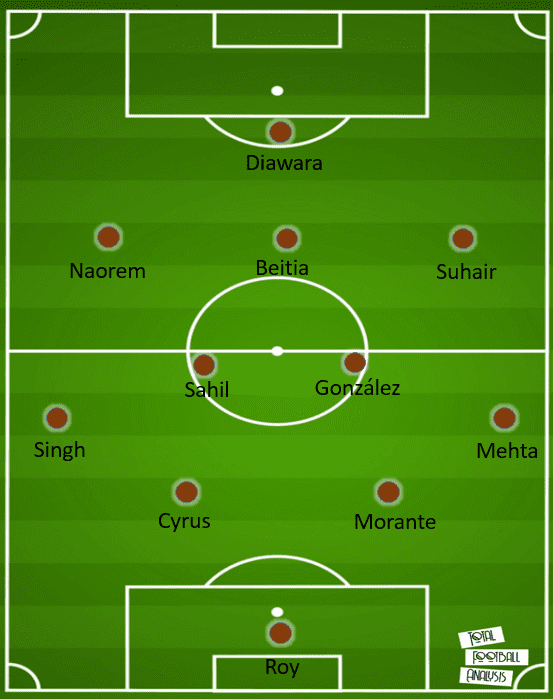
However, there were various changes in the personnel throughout the season due to injury and card issues. The major change was that when one of the centre-backs would be missing out, González would drop to the heart of the defence, Beitia would act as the double pivot alongside Sahil, Suhair would play in the hole and Komron Tursunov would occupy the right-wing position.
Without further ado, let’s dive into the concepts of Vicuña’s possession-based football that would be discussed further in the analysis.
Concepts of Vicuña’s possession-based football
Vicuña brought a brand of football to India which very few expected. Like many other top sides, he believes in his team playing a possession-based game. He incorporated a few unique methods of build-up from the back. He is very flexible and always adapts to the situations, however, the concepts or philosophy behind Vicuña’s brand of football is similar to most modern coaches.
The gaffer’s philosophy revolves around:
- Overloading the area of play
- Extreme use of half-space
- Players positioned in between the lines
- Rotations to create space
- Enormous use of triangles
- 3rd man principle
- Vertical passing
Through various phases of possession play, the Spaniard showcases these concepts.
Overload during build-up
On paper, it may show Mohun Bagan plays with a 4-2-3-1 formation. However, due to continuous rotations, it is hard to pinpoint a specific formation to Mohun Bagan’s build-up structure. It shifts from 4-2-3-1 to 4-4-2 to 3-5-2 to various other formations depending upon the situation created by the opponents.
In this modern era, most of the possession-based teams look to overload their first build-up phase with three-man at the back. However, Vicuña likes his midfielder drop to form a three-man backline only when it’s necessary.
When building-up from the back, it’s González who always gives the shortest passing option to his centre-backs. If the centre-backs don’t find a way to pass to the Spaniard, he drops to form a three-man backline.
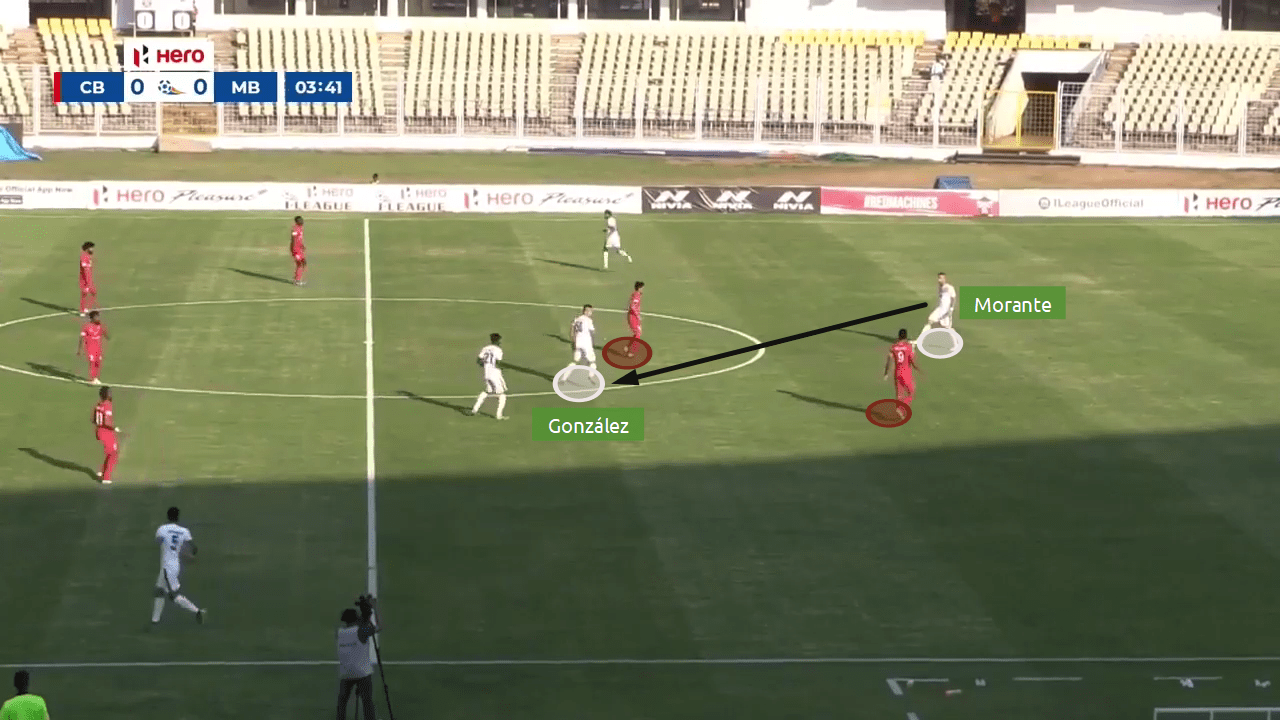
In this screenshot, the two Churchill Brothers strikers mark the two centre-backs. However, no one cuts the passing lane to González. So, he doesn’t drop and Morante passes the ball to him breaking the first line of Churchill defence.
Even though Mohun Bagan plays with double pivot, Vicuña likes to use González as the lone pivot pushing Sahil further up during the build-up. So, most of the times a pass to González is well blocked by the strikers pressing the centre-backs. In that case, the midfielder falls back to form a three-man backline and stretch the first line of build-up. The Spaniard uses it, especially against a two-man press upfront. It creates a 3 vs 2 situation in the first line of build-up and stretches the first line of the opposition press.
Vicuña loves to build out from the back with a lot of vertical passing rather than playing lateral passes among the defenders. The centre-backs are the major pillars to progress the ball to the middle third or the opposition half and especially Morante who records 12.23 progressive passes per 90, second highest in the league. The vertical passing Mohun Bagan indulges in is mostly through ground balls which makes it easier for the Mariners to build-up keeping possession as well as break the opposition’s defensive lines.
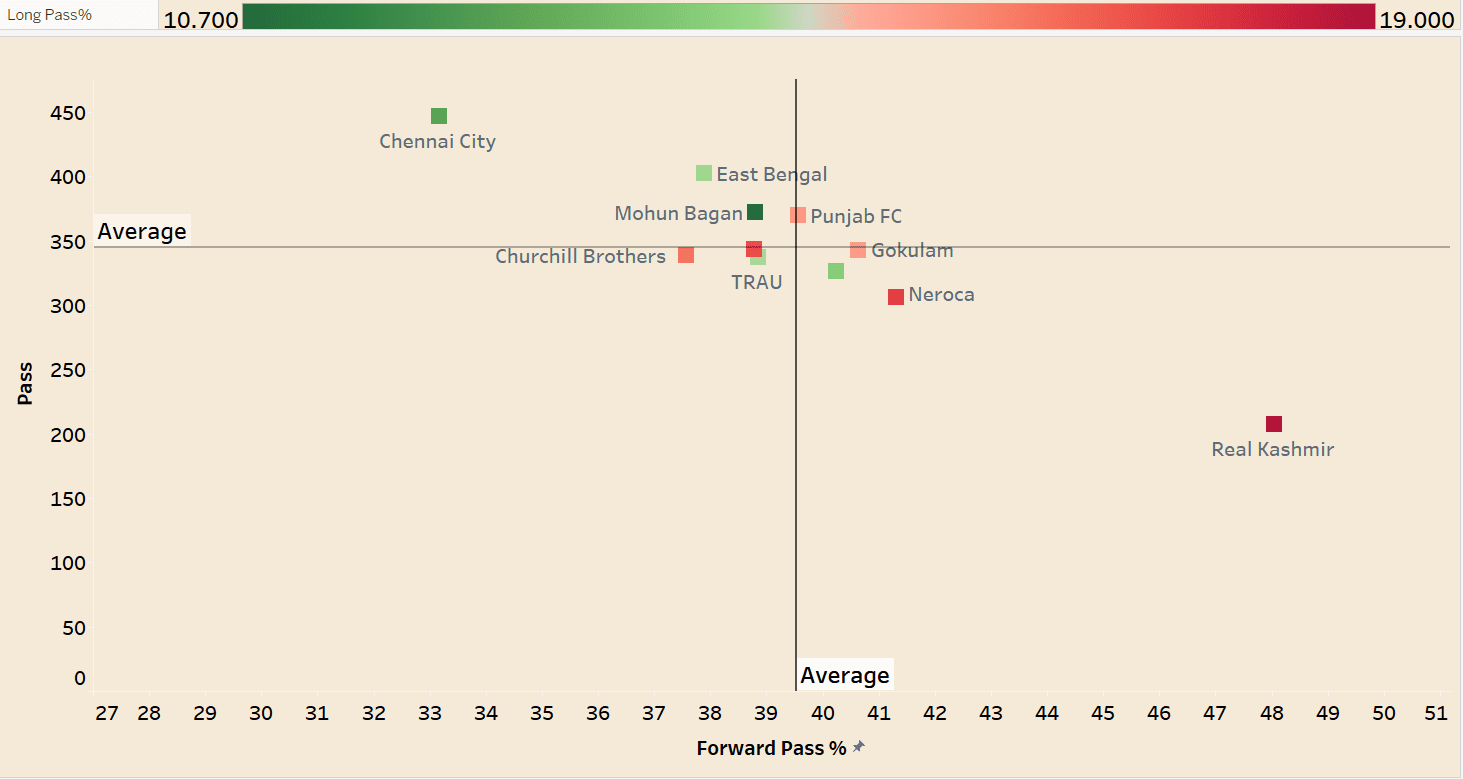
The above graph validates the statement made above. Mohun Bagan plays 372.1 passes per 90, lesser to only East Bengal and Chennai City and almost similar to Punjab FC. Among these teams, even though Punjab FC plays more forward passes, they play a large number of forward passes through long balls whereas Mohun Bagan’s long pass % is only 10.70 of the total passes made.
When both the strikers mark González and the other centre-back, Morante carries the ball forward to the open space and attracts a midfielder before his next action.
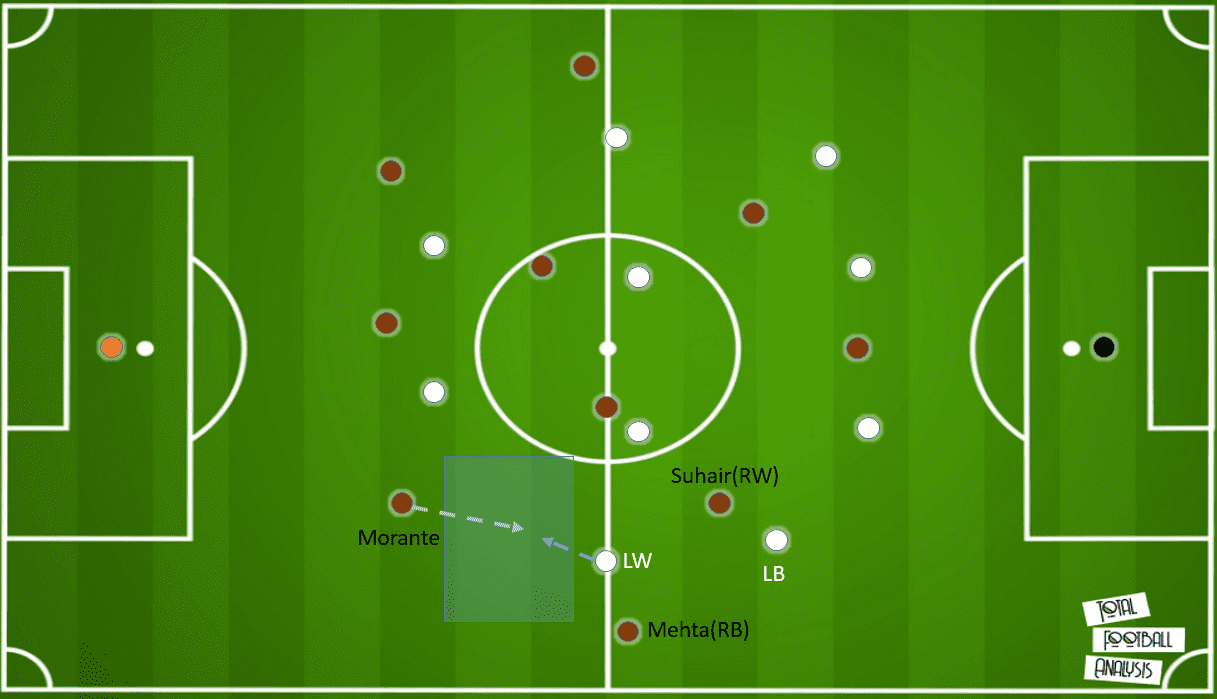
When the midfielder is attracted towards Morante, this is where Mohun Bagan uses two other principles along with overloading, ‘use of half-space’ and ‘3rd man principle’.
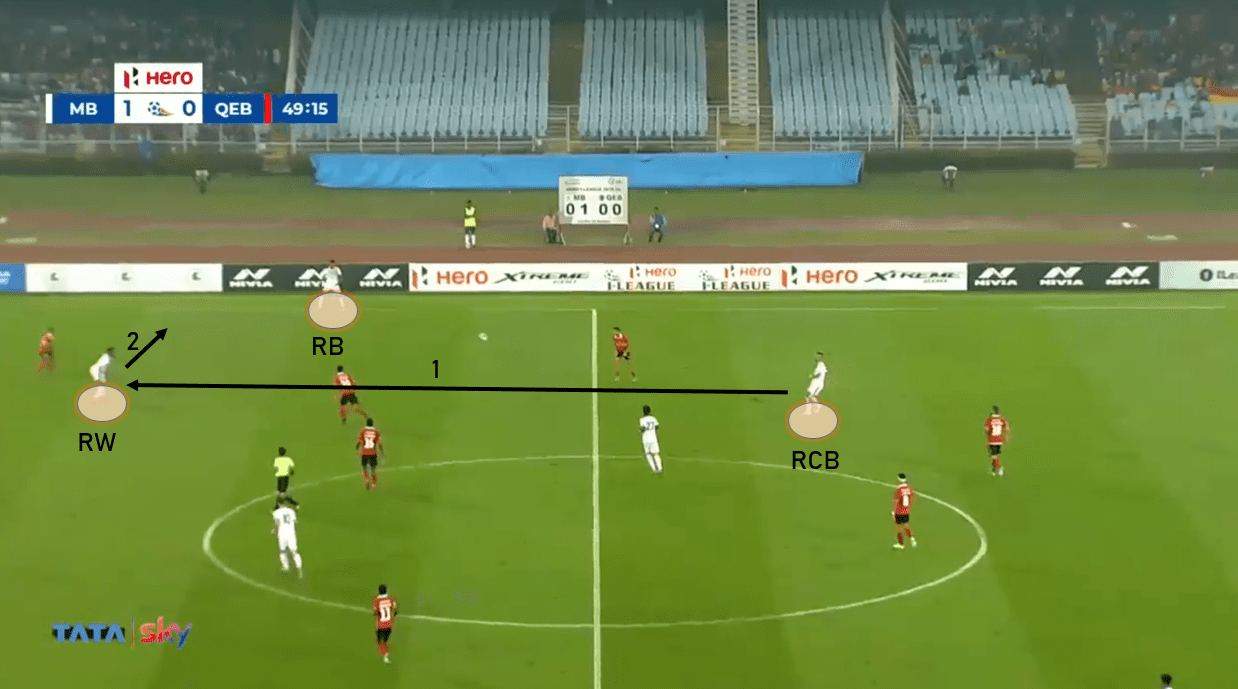
The screenshot above vividly describes the above principles. When Morante carries the ball to the middle third, the East Bengal LW tries to press him. When the LW intends to press Morante, Mehta (RB), moves to the opposition half and occupies the flank and Suhair (RW) inverts and occupies the half-space. Both the players create an overload on the East Bengal LB. Morante passes the ball to Suhair who is the 3rd man now and he chests it down to Mehta who progresses the ball to the final third.
Overload one vertical half of possession
Continuing from the previous section, we can even see a similar setup on the opposite flank. Along with the progression of the ball by a centre-back, it also depicts the overload of one vertical half of the field.
Beitia starts in the ‘hole’ but acts as the free player who deals with rotation the most to create overloads in each phase of play. This is the advantage of playing with 4-2-3-1. The free player can roam around the entire field and create overloads whenever necessary.
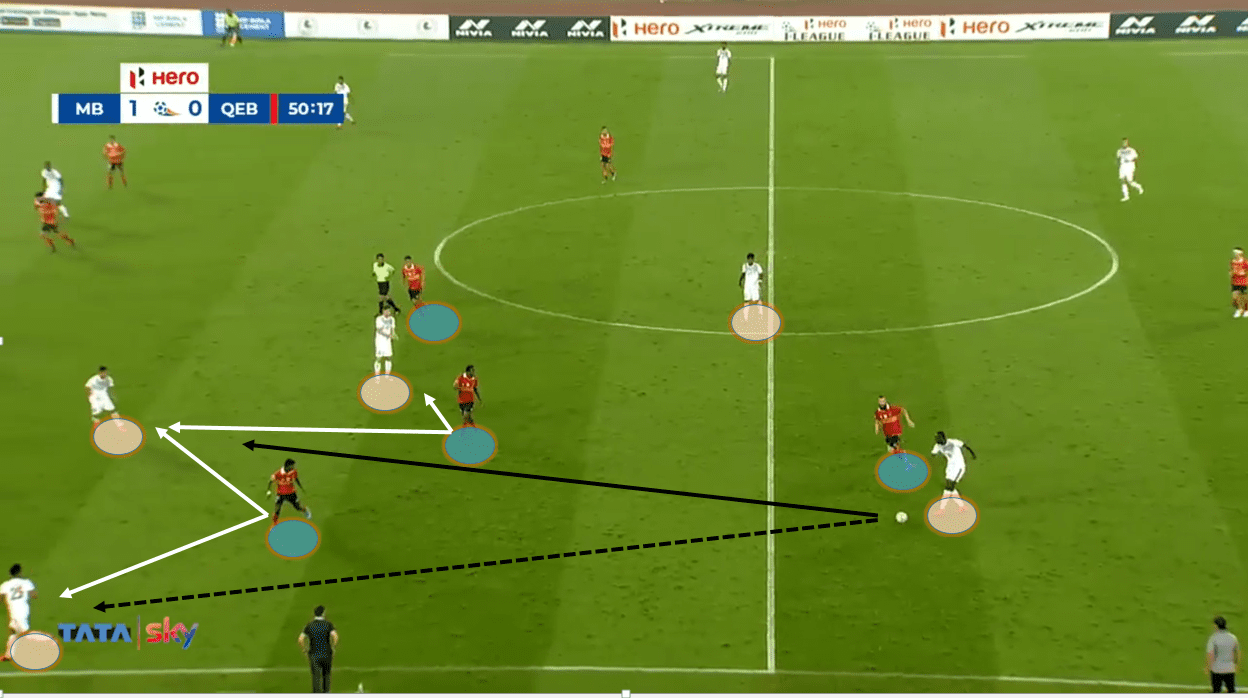
Here, the striker follows Cyrus (LCB), so East Bengal has a four-man midfield intact. However, with Naorem (LW) inverting to the half-space and Beitia (CAM) moving the left vertical half, it creates a 5 vs 4 overload on the left vertical half. The East Bengal RW can’t completely block the passing lane to Singh (LB) who has moved higher since Naorem would be an easy pass for Cyrus. East Bengal RCM can’t block the passing lane to Naorem since Beitia would then be left empty. Eventually, with such conundrum, East Bengal fails to block the passing lanes to Naorem and Singh.
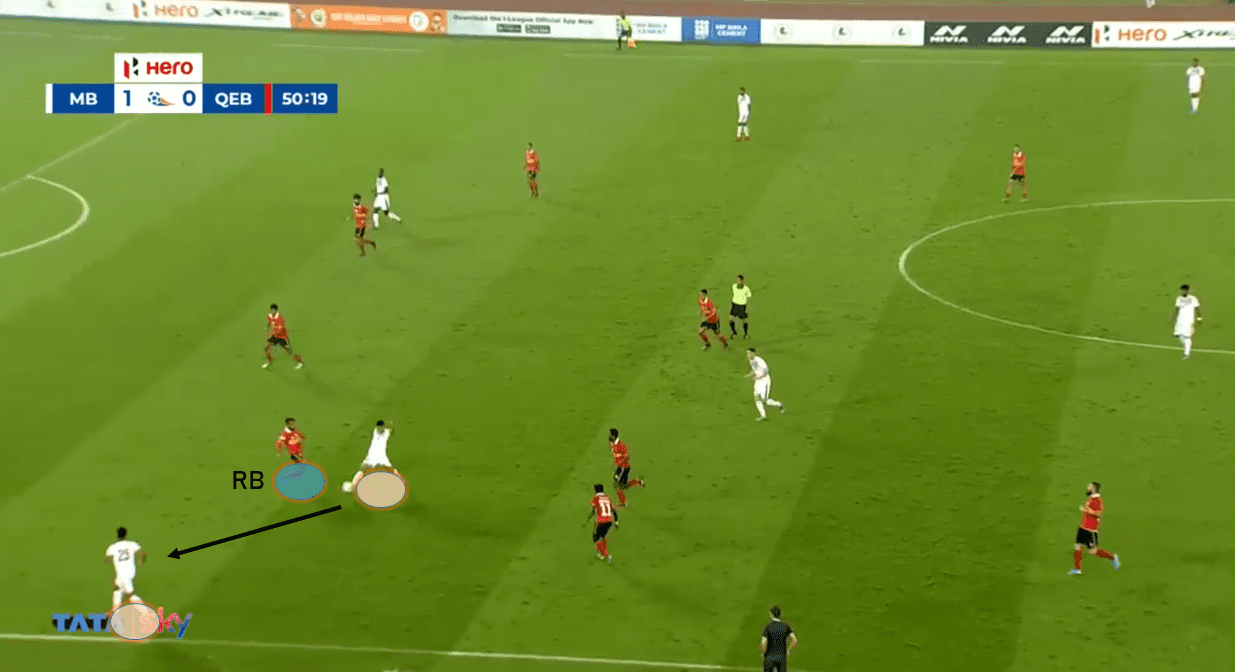
However, Cyrus doesn’t pass to Singh, rather prefers to opt for 3rd man principle, and passes to Naorem. Since East Bengal RW’s body orientation is towards Singh and with RB pressing from the front and him pressing from the back would have trapped Singh and also Singh has to receive the ball with a tilted position, which would make it easy for the East Bengal RB to cover the space and recover the ball. This is where the use of half-space is so essential. With Naorem in possession, he has the option to pass the ball to both Beitia as well as lay it off to Singh and along with Singh he also overloads the East Bengal RB. With Naorem attracting pressure from the East Bengal RB, he lays it off to Singh and the LB overlaps and progresses the ball further unhindered.
In both the above scenarios, when the wingers occupied the half-space, they also positioned themselves in between the midfield and defensive line. This is another important aspect of Vicuña’s build-up model.
Mohun Bagan loves to build-up from the right flank owing to Morante’s immense ball progressing and passing ability, which can be seen in the image below.
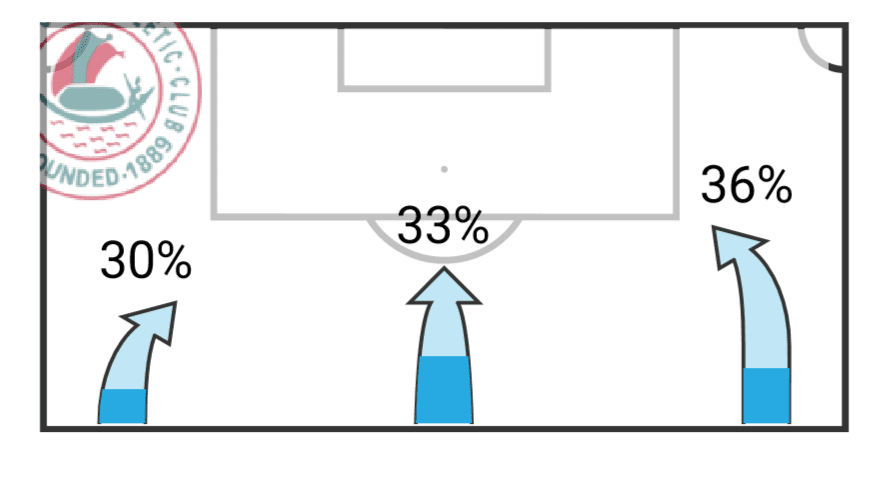
When Morante progresses the ball either he creates an overload in the right flank or he plays a progressive pass for the attacking players to create an overload and he provides the depth, which is another important aspect of Mohun Bagan’s possession-based game.
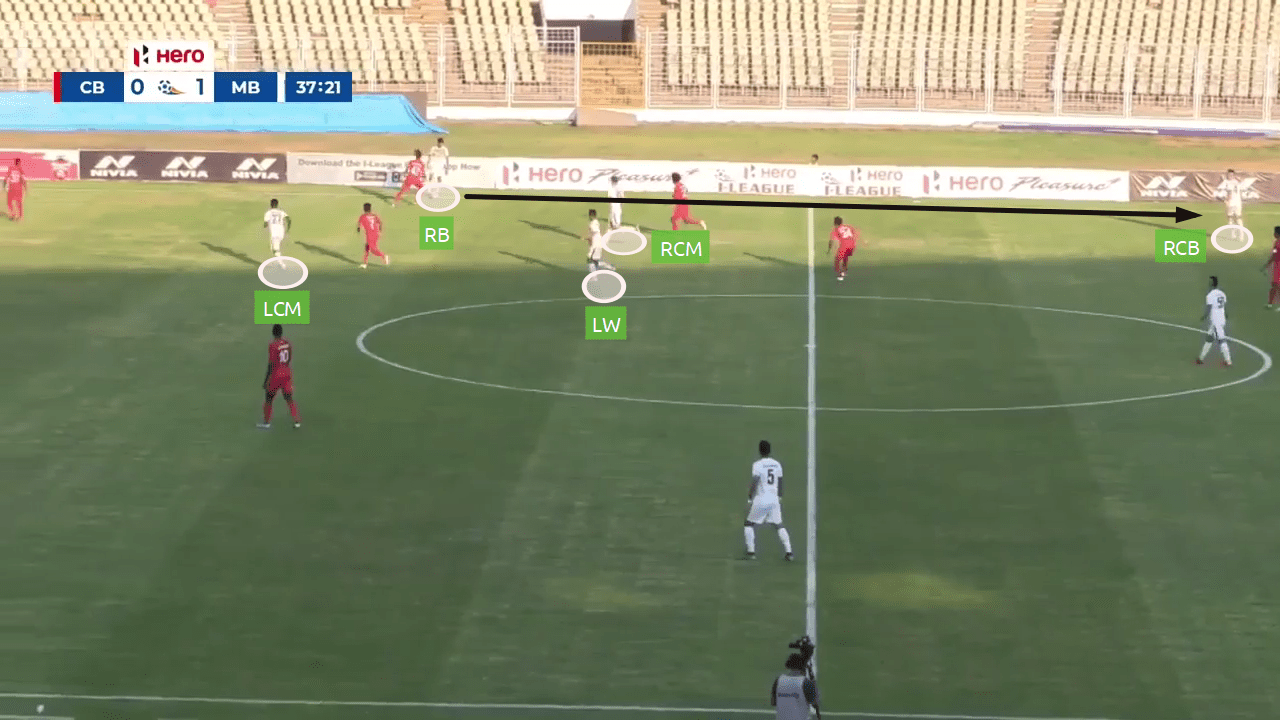
Here, Naorem joins Beitia, Mehta and Sahil in the right flank and creates a 4 on 3 overload. Height is provided by the striker and the RW who has inverted and pinned the left-back and LCB of Churchill in order to maintain the overload. Mehta who doesn’t have any option to progress the ball through an overload opts to use the depth provided by Morante who starts to build-up yet again.
The Spanish coach doesn’t believe in maintaining width in both the flanks and thus stretching the opponent. Rather he intends to progress the ball by creating overloads on either flank. This is one reason you would often find Naorem (LW) joining the attack in the right-flank or Suhair (RW) positioning himself in the central channel when the possession is in the left flank.
However, he occasionally uses the overload to isolate his player on the opposite flank.
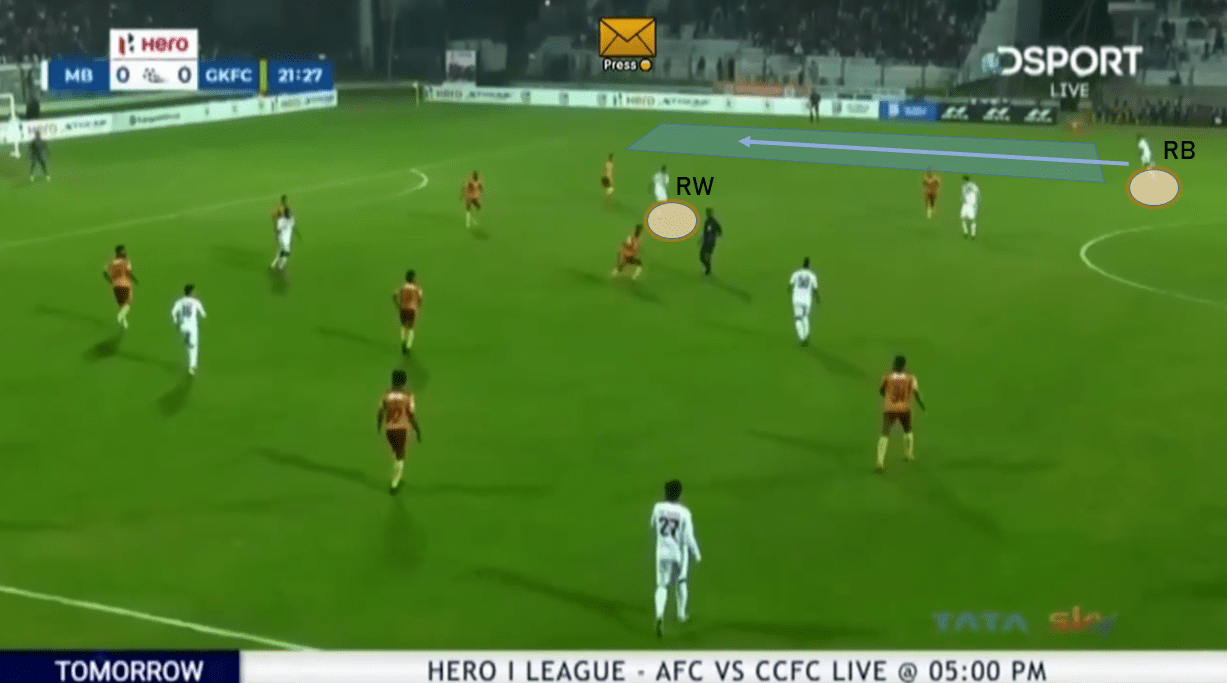
This is an instance against Gokulam Kerala. Mohun Bagan were building-up from the left flank. Mohun Bagan right-winger positions himself in the half-space and pins the LB. Mehta (RB) makes a deep run and looks to exploit the space created by the overload on the opposite vertical half.
Using rotation in triangles
Mohun Bagan use rotation to a large extent either in the build-up to progress the ball higher or in the final third to put the final nail in the coffin.
The triangles are mostly seen in the build-up phase between the full-backs, CM and a winger or centre-back, CM and a full-back which indicates Mohun Bagan mostly builds-up through the flanks. Even in the final third, they create triangles in the flanks to create space through rotation and produce a key pass.
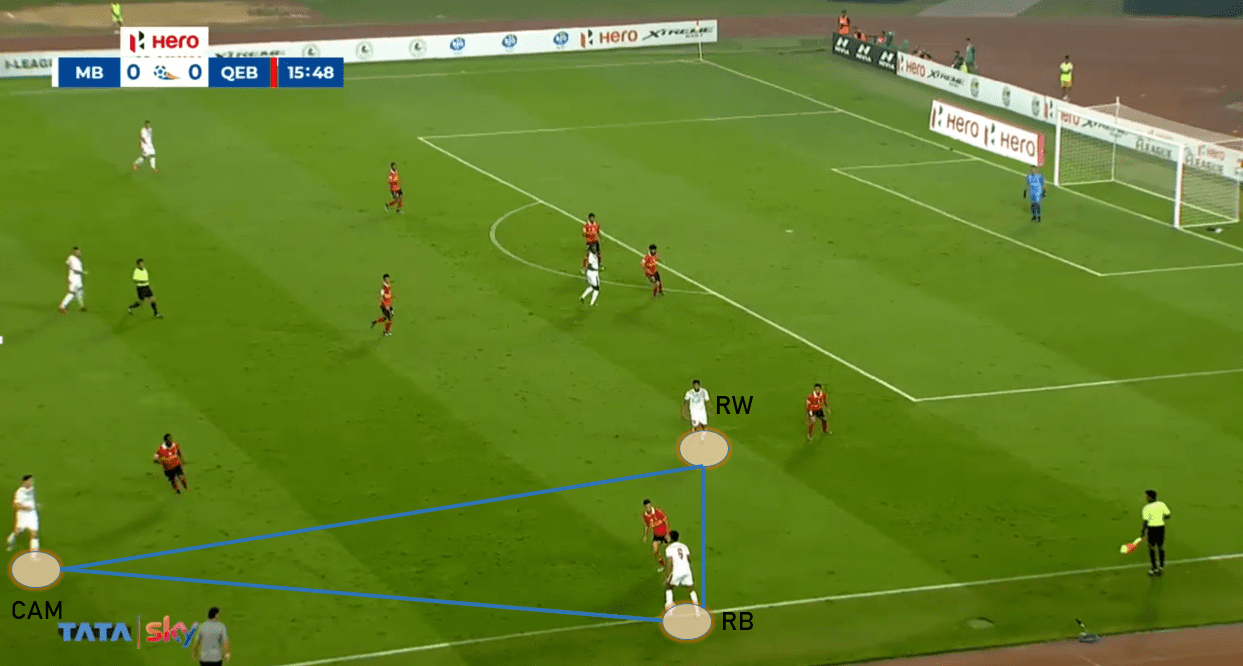
Here, Beitia (CAM), Suhair (RW) and Mehta (RB) form a triangle. Three East Bengal players mark the three Mohun Bagan players and thus eradicating the overload. However, the Mariners easily break through the three East Bengal players through ‘pass and move’ which is the key to rotation in possession.
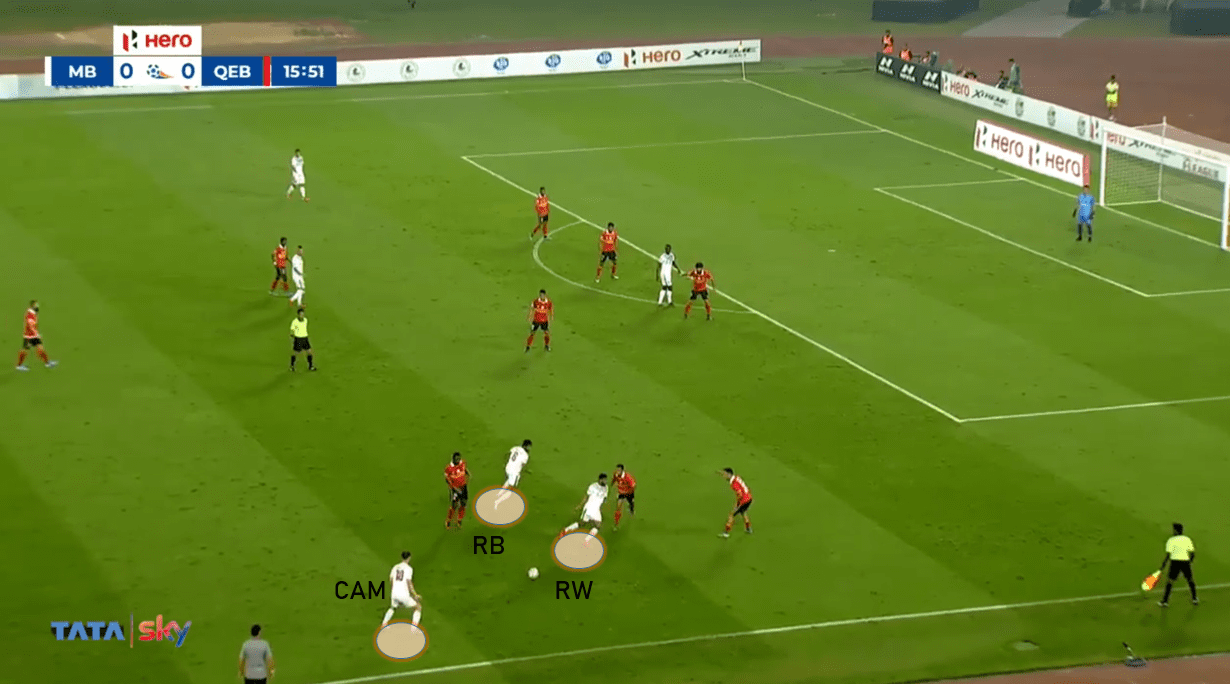
Mehta passes to Suhair, moves towards his direction attracting the East Bengal winger towards himself and thus creating space for Beitia to receive in Mehta’s initial position.
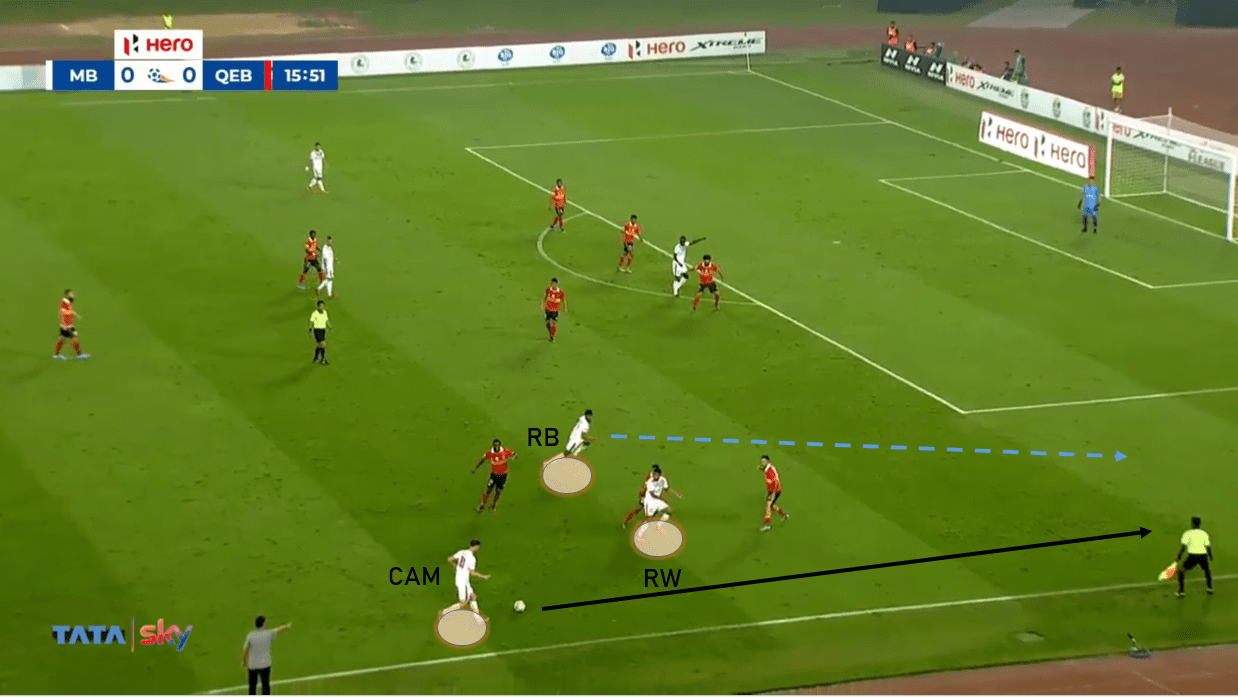
With Beitia in free space, he attracts the attention of the East Bengal LW who was marking Mehta and he directs his teammate (LCM) to follow Mehta’s run. He notices Mehta is already ahead of the CM and thus tries to move back and track Mehta’s run. However, Mehta is already in a forward motion which helps him to move to the space left behind by the Lal Holud LB, whom Suhair forces out of his position, much quicker than the opposition LW. Beitia passes the ball to Mehta in the space and the right-back crosses it to the box with a lot of space and time. However, his poor cross let the team down.
Vicuña loves to play a possession-based game. However, it does not mean he would just play lateral passes and keep the possession. Rather, it’s the vertical passes and the use of all the six concepts that leads to Mohun Bagan’s successful attack.
Protecting the half-space
Kibu Vicuña is flexible even in his defensive organisation. He sets up his team with respect to the opposition’s build-up pattern. The striker and the CAM form the first line of press and goes with either man-marking the opposition centre-backs or ‘pendulum pressing’. Pendulum pressing means the forwards won’t go for aggressive pressing rather they would be blocking the passing channel to the opponent’s pivot. One player would be behind the pivot to mark him closely and another would be moving towards the opponent’s centre-back who has the ball in his feet. The player moving away from the pivot generally provides a cover-shadow and prevents the passing lane to the pivot. The Mariners’ general defensive formation becomes 4-1-3-2 in this case.
A manager who uses the half-space to exploit the opposition surely knows how important is to protect the half-space. He uses both the wingers to protect the half-space. When not man-marking, the wingers occupy a position between the full-backs and the CMs, closer to the CMs and body orientation directed towards the full-backs.
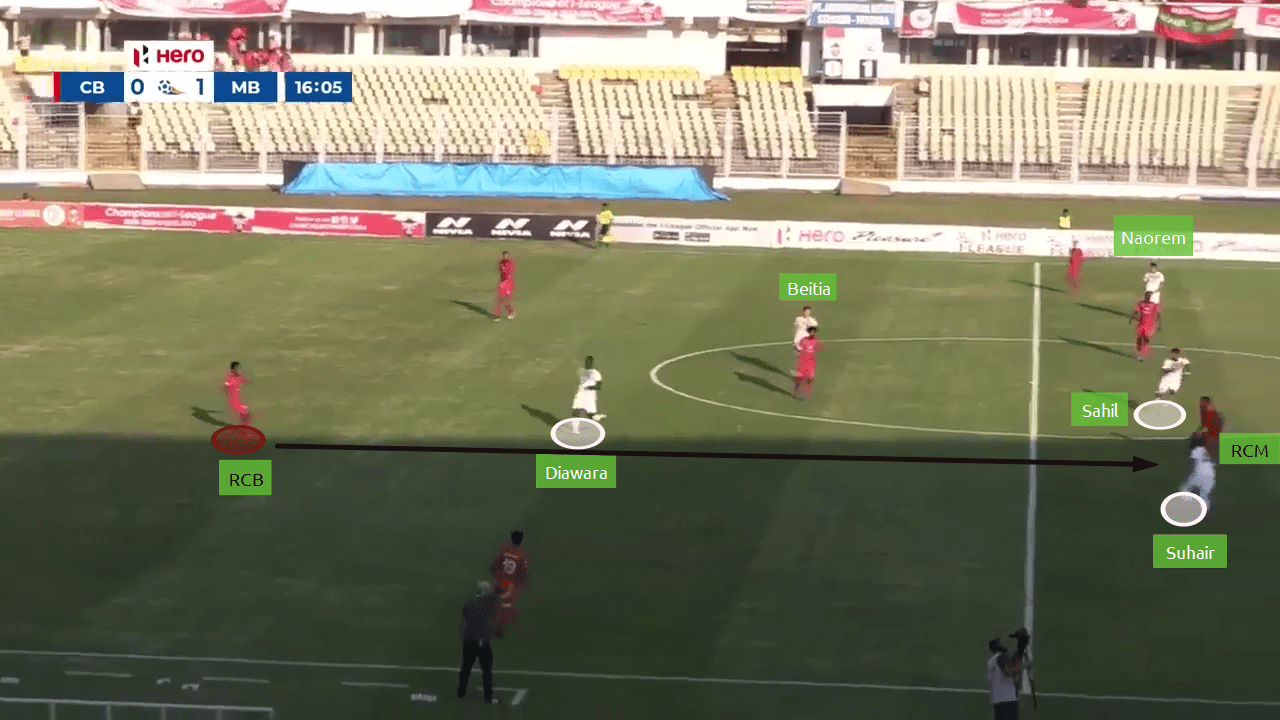
In this situation, Suhair and Naorem exchanged their position and acted as LW and RW respectively. This screenshot gives a clear indication of Mohun Bagan’s pressing structure. The two forwards pendulum pressed, with Diawara moving towards the ball carrier centre-back cutting out the passing lane to the pivot and Beitia closely following him from behind.
Suhair and Naorem positioned themselves in between the full-backs and the CMs and Sahil in between the two Churchill CMs. Both the wingers maintained a position closer to the respective CMs than the respective full-backs. When Churchill’s centre-back played the ball to the RCM. Suhair immediately latched onto him and recovered the ball.
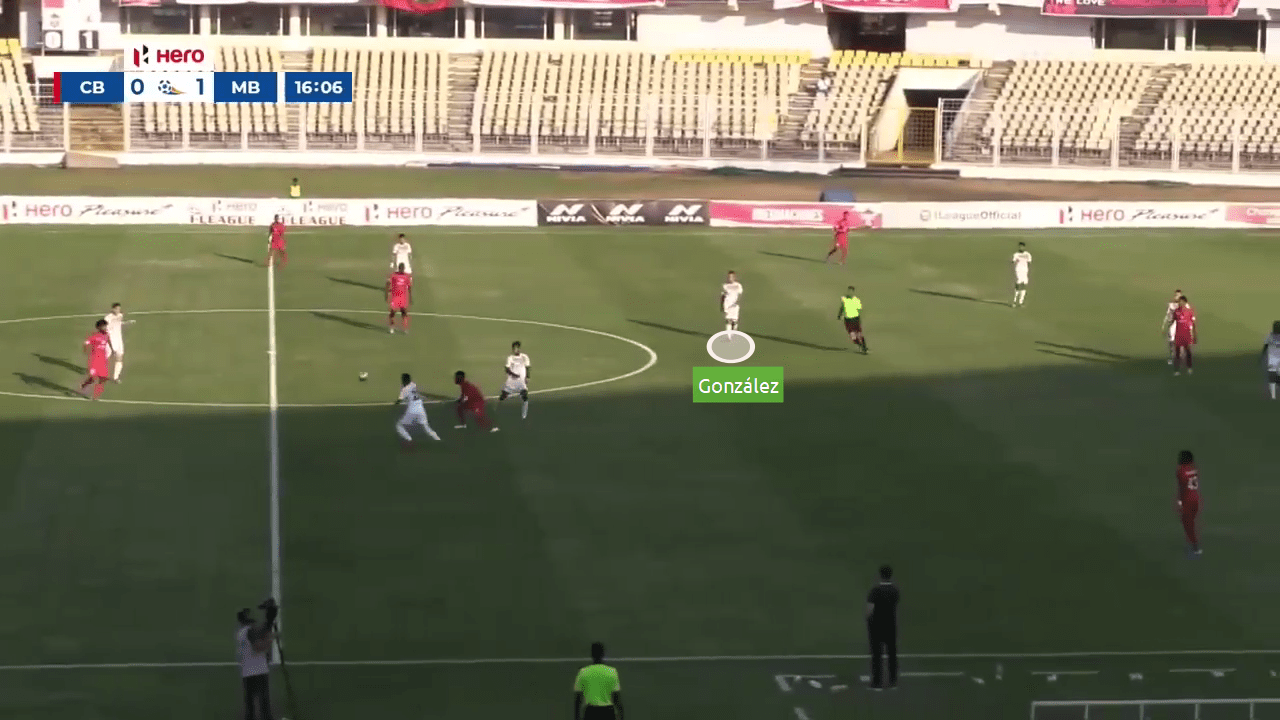
Fran González sat in between the second line of defence and the final line of defence to give an extra layer of protection. The two areas (‘half-space’ and ‘ space between the defensive lines) Vicuña looks to exploit in the opponent, are the ones which he always protects.
The main intention of this structure is to push the ball towards the flanks and then create a pressing trap. When the full-back receives the ball, the Mohun Bagan winger presses him inwards or outwards depending upon the situation. When Sahil marks the immediate opposition midfielder closely, the winger presses him from outside thus blocking the passing lane to the winger in the flanks. When Sahil is a bit far from the immediate opposition midfielder, the winger presses him from inside thus cutting the passing lane to the immediate midfielder. In this case, if the full-back passes the ball to the winger, Mohun Bagan full-back and the winger presses him from both the front and the back and tries to win back the ball.
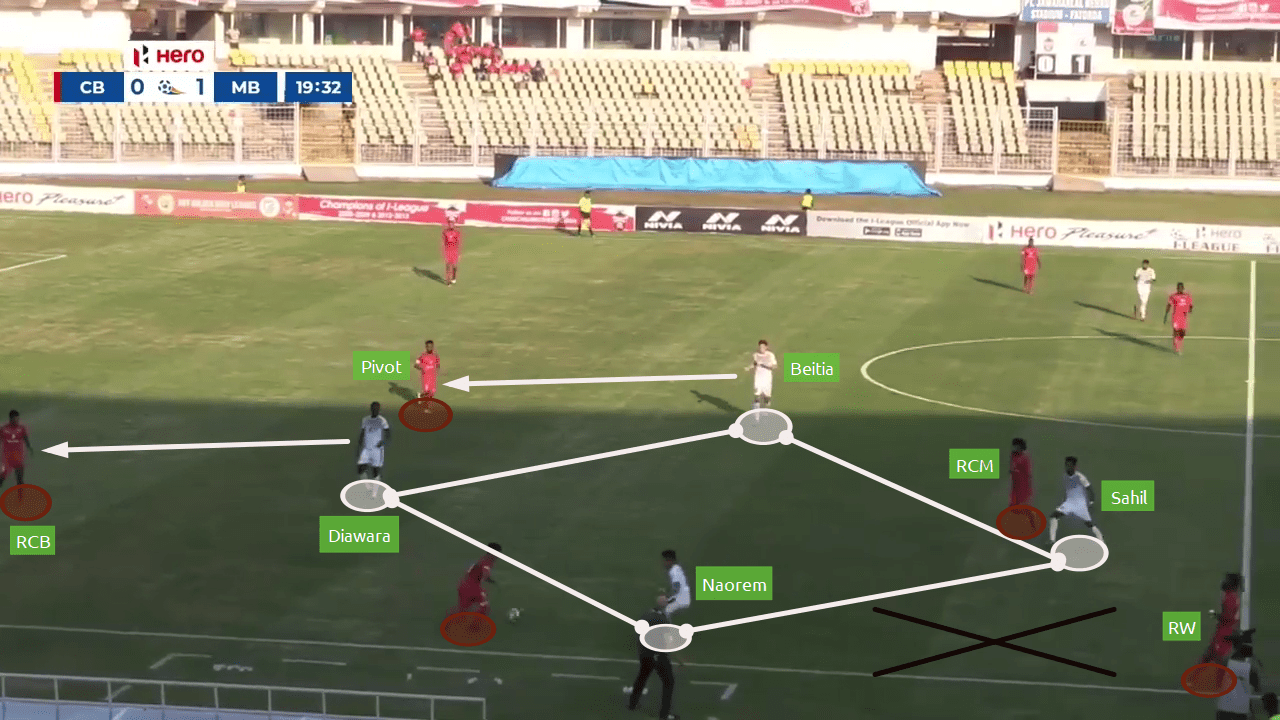
Here, the opposition RCB passed the ball to RB. Once the pass was made, the press was triggered. Naorem performed an outward press thus cutting the passing lane to the opposition RW since Sahil closely marked the immediate opposition midfielder. Churchill RB’s all the immediate passing options were blocked. A trap!! However, the RB got out of the trap by passing it to the pivot who dropped deep to form three-man Churchill backline.
Naorem is brilliant when it comes to pressing by manipulating his body angles and thus manipulating the opposition to go for risky passes and eventually losing the ball.
Apart from space-oriented man coverage, Mohun Bagan also indulges in solely man-oriented pressing or man-marking especially against the teams who love to play out from the back profusely.
Against Punjab FC, Mohun Bagan went for man-marking since Yan Law’s side love to play out from the goalkeeper and recorded a mere 6.12 and 6.32 PPDA (Passes Allowed per Defensive Action) in both the games.
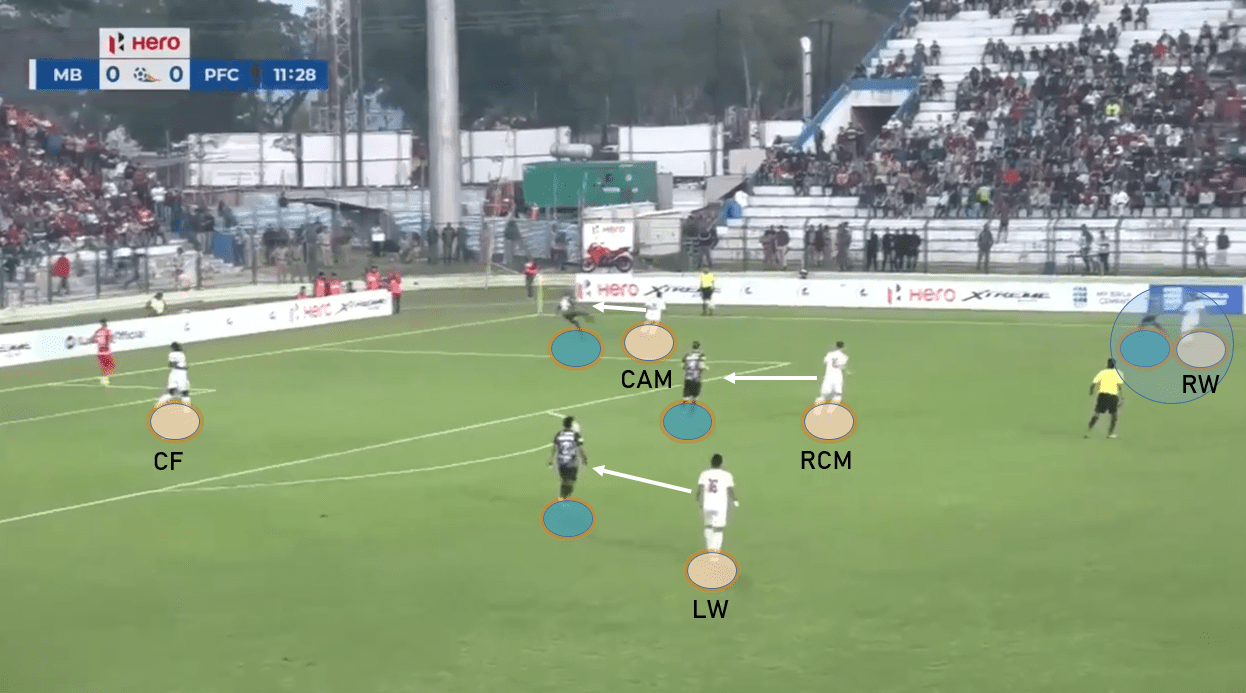
In this screenshot, you can easily notice how Naorem (LW) sticks to Punjab’s RB who has inverted, Beitia (RCM) stays with the Punjab pivot. Suhair (CAM) marks the Punjab LCB and Tursunov (RW) aggressively presses the Punjab LB.
Even in the middle third, once the opposition has penetrated Mohun Bagan’s first line of defence, you could see a similar 4-1-3-2 structure with Fran occupying a position in between the final defensive line and the second defensive line.
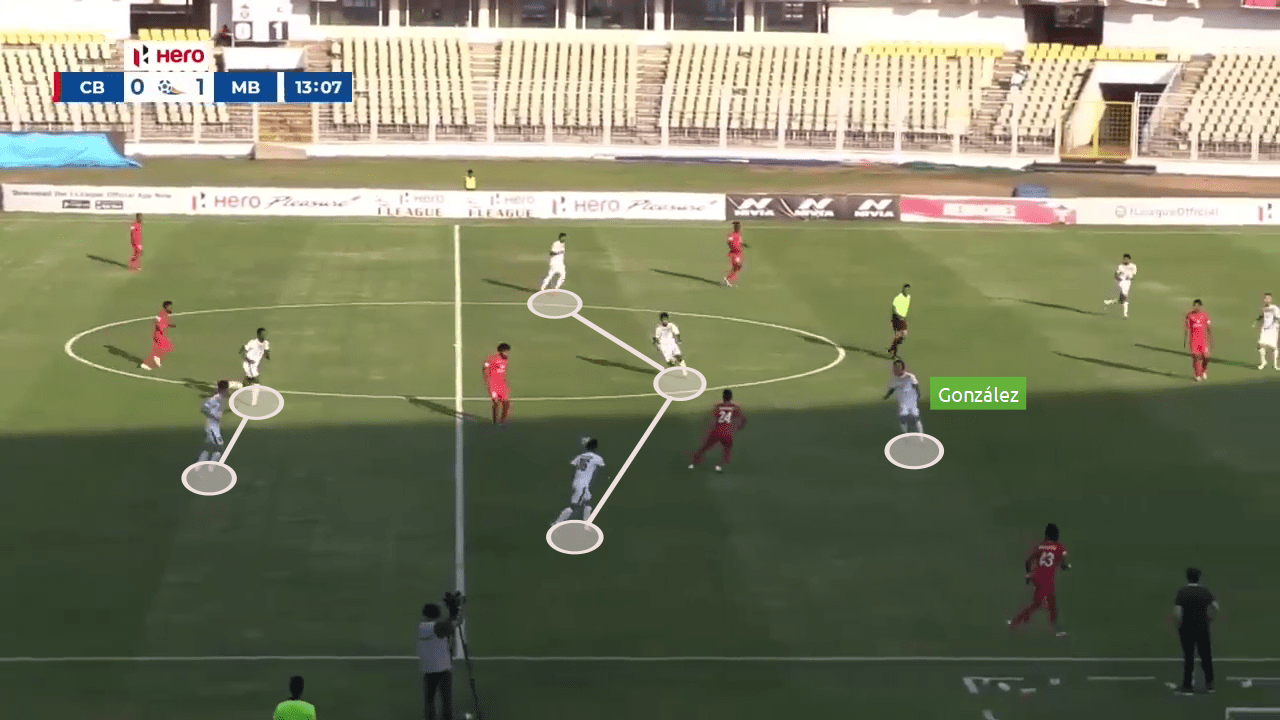
However, Beitia always drops to help his teammates and Diawara often keeps a bit of height ahead, if in case a counter-attack is on the cards.
Transitions
Overloading the area of build-up can open up space in other areas. Overloading during the build-up has another minuscule advantage other than successful build-up, which is it helps to recover the ball quickly.
However, when in the final-third overloading one flank leaves a huge space on the opposite flank, which is where teams should have exploited Mohun Bagan but the goals conceded tally clearly shows Mohun Bagan were able to plug the gap.
Mohun Bagan like to keep a short distance between their players on the flanks when in possession. So, when the Mariners lose the ball it becomes easier for the Mariners to cut the passing lanes. It’s almost impossible to go for aggressive counter-pressing when the ball is lost owing to India’s hot and humid environment, so one player always pressurises the opposition ball carrier and the others look to cut the passing lanes to prevent the switch.
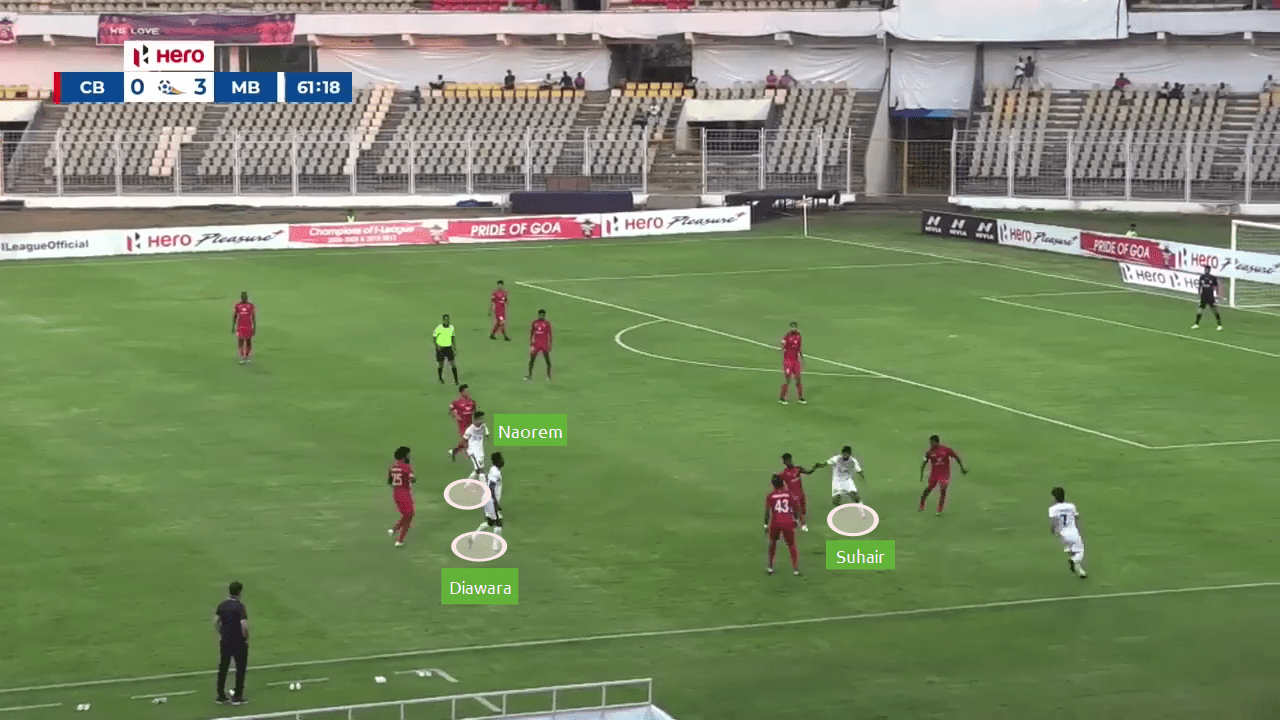
Here, Diawara plays a poor pass and a Churchill midfielder intercepts the ball. As soon as he intercepts, Suhair pounces on to him. Naorem and Diawara cut the forward passing options. What happens is that it does not give the ball carrier time and space to switch or play a forward pass to progress the ball.
Even sometimes when the opposition pokes the ball, the ball eventually gets to another Mohun Bagan player.
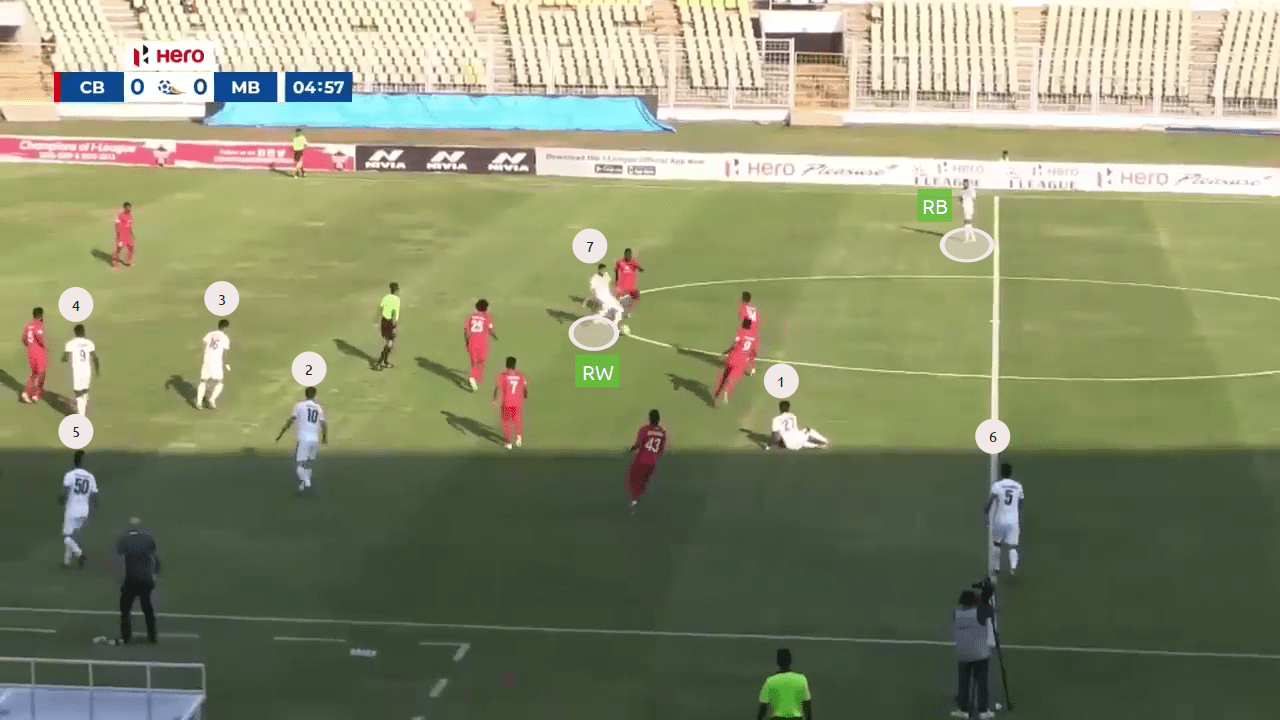
Here, almost all the outfield players are on the left vertical half. Even Suhair occupies the central channel from right-wing. When Churchill Brothers’ #9 toe-poked the ball from Sahil, it eventually went to Suhair’s foot. The right-winger used the depth by playing it backwards after recovering the ball.
However, there are sometimes when it becomes impossible to block the passing lanes either due to lack of pressure or due to the opposition’s brilliant footwork. This occasionally causes the Mariners with headaches.
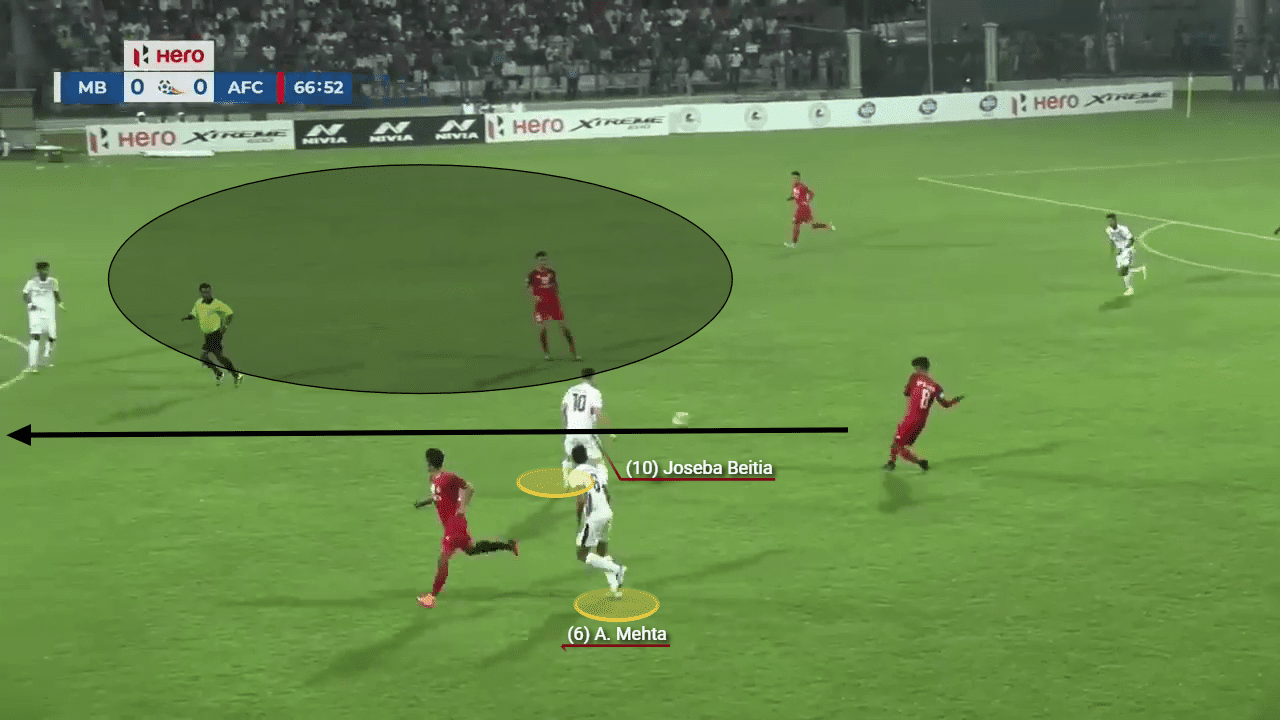
Here, Tursunov (RW) loses the ball, Naorem (LW) was ahead of him. Tursunov doesn’t put pressure after losing the ball. So, Beitia (RCM) and Mehta (RB) preferred to cut the passing lanes rather than one pressing him. It gave the Churchill midfielder time and space to think of his passing options. There is huge space left open by Mohun Bagan in both the right flank as well as in the central channel. The Churchill Brothers midfielder passes it forward to his striker. Fortunately for the Mariners, it did not result in a goal.
Mohun Bagan look to tackle such situation by inverting the opposition full-back in the opposite half-space or the central channel or the most common method Vicuña uses is instructing González to screen the defence by staying deep. However, it does not always bail Mohun Bagan out. The Mariners conceded two goals from counter-attacks in 16 games, which is the second-highest by any team in this category.
Mohun Bagan do look to counter-attack on their own, however, it’s not one of their strong points. They are a possession-based team with much importance in vertical passing which indirectly helps them in counter-attacks too.
Conclusion
Sergio Lobera, the former Barcelona youth manager, had massively influenced Indian football by bringing in possession based football. Kibu Vicuña has introduced possession based football with the focus on vertical passing. The game does not get affected if a team has 80% possession but mostly plays lateral passes. This concept of vertical passing was introduced to the Red Bull teams by Ralf Rangnick. It is now to be seen if this brand of football establishes Vicuña’s legacy in India.
Mohun Bagan have dominated the league with Vicuña at the helm and there is no denial. The scintillating and enthralling brand of football helped Vicuña move to Kerala Blasters. The Tuskers are a sinking ship, however, it is to be seen if Vicuña is able to steady the sinking sheep and give a ray of hope to the Blasters’ fans especially Manjappada who have always lit up the atmosphere in Indian Super League.





Comments